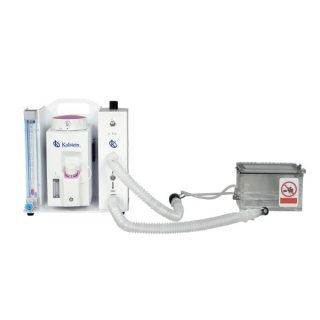There are different varieties of anesthesia machines for veterinary use, and each of them consists of essential components that ensure their proper functioning.
1. Continuous Flow Anesthesia Machines: This type of machine continuously supplies a mixture of oxygen and anesthetic gas to the patient, ensuring a constant and reliable supply during surgery.
2. Intermittent Flow Anesthesia Machines: Unlike continuous flow machines, this type of machine supplies the mixture of oxygen and gases at regular intervals.
In addition, all these machines include basic components such as the vaporizer, which converts liquid anesthetics into gas, the breathing system that delivers the anesthetic to the animal, and finally, the waste disposal system, which safely discards excess gases from the machine.
Today, veterinary anesthesia machines are considered one of the essential equipment in any veterinary operating room. In their hands lies the responsibility of providing a safe and effective anesthetic procedure that ensures the well-being of animal patients. In this article, we will delve into the crucial role that anesthesia machines play in veterinary surgeries.
The Importance of the Veterinary Anesthesia Machine
The health and well-being of animals are a fundamental priority in veterinary medicine. In this context, anesthesia machines play a decisive role, as they are responsible for delivering a precise dosage of anesthetics safely and controlled during the surgical procedure.
In addition, the anesthesia machine also continuously provides oxygen to keep animals in a stable state during the operation. So, without a reliable anesthesia machine, veterinarians would be at a disadvantage when facing surgical procedures that require precision and safety.
Maintenance and Safety in the Veterinary Anesthesia Machine
An essential component of a reliable and safe anesthesia machine is proper maintenance. In addition, safety protocols must be strictly followed to minimize the risks of accidents.
In general, anesthesia machines should be cleaned and disinfected after each procedure. Additionally, it is also necessary to ensure that tube connections are securely sealed and that controls are properly calibrated.
Furthermore, regular evaluation and various system checks are mandatory to ensure optimal operation. This includes checking the condition of seals, valves, hoses, and pressure in the system.
The Veterinary Anesthesia Machine as an Indispensable Tool
In summary, veterinary anesthesia machines are vital equipment for any veterinary clinic or hospital. Their presence ensures a safe, efficient, and effective anesthetic procedure. With technological advances and increasing interest in animal health, veterinarians and pet owners can feel confident that their animals will be in the best hands during their surgical procedures.
Let’s also remember the importance of the machine operator in the animal’s safety. This personnel must have in-depth knowledge of the machine’s operation and maintenance to ensure safe anesthesia.
Thus, the veterinary anesthesia machine stands out as a key element in performing safe surgeries, becoming an essential component in 21st-century veterinary medical practice.
If you want to know the catalog of high-end products that we have for you at KALSTEIN, visit us at https://kalstein.pl/. We also assure you that through our online PURCHASE channels, which are very easy and viable, you will find the best PRICES on the market. Remembering that we are a MANUFACTURING Company of high-level Laboratory Equipment for SALE. https://kalstein.pl/category-product/veterinary-sector/veterinary-anesthesia-machine/

